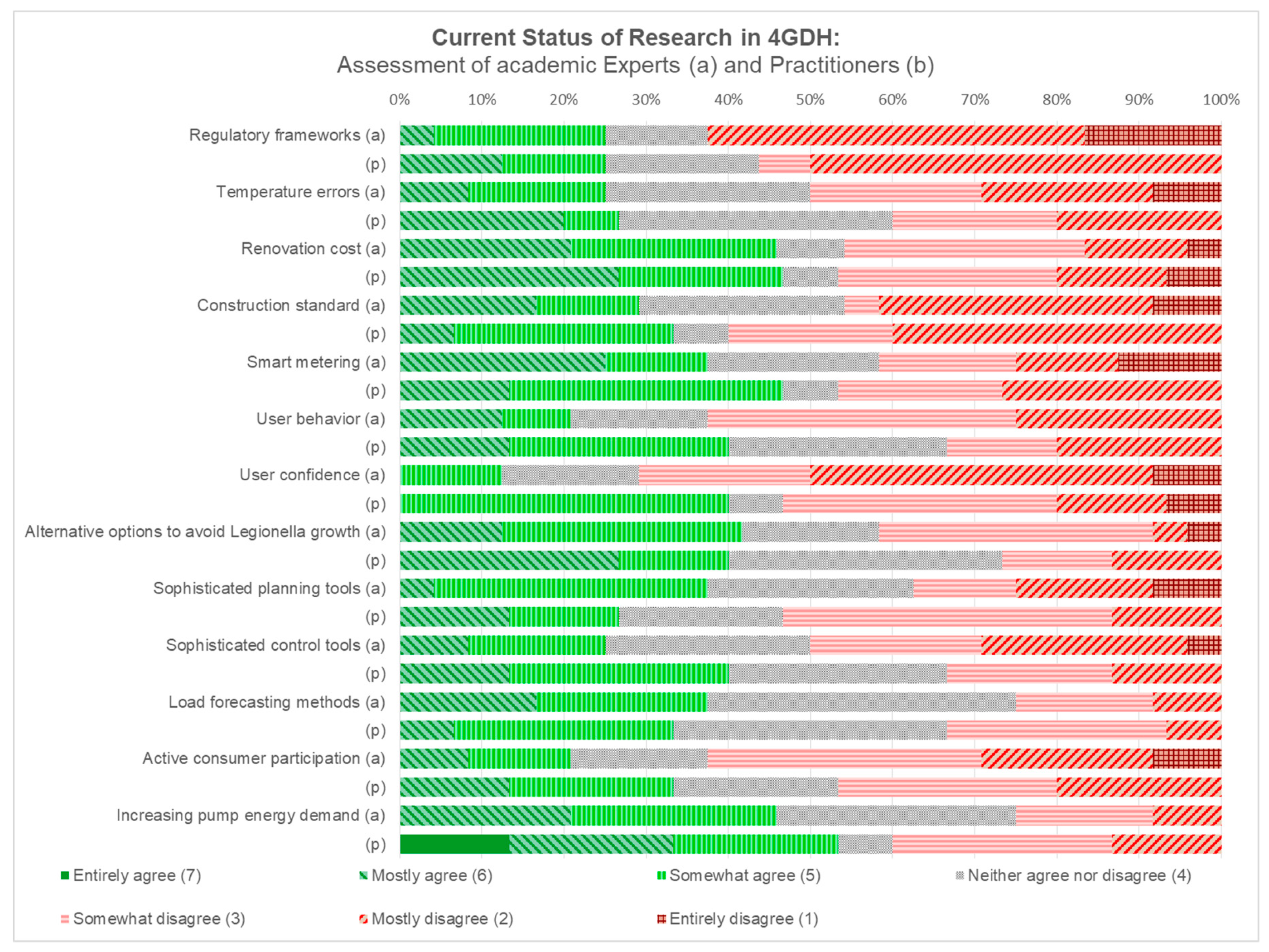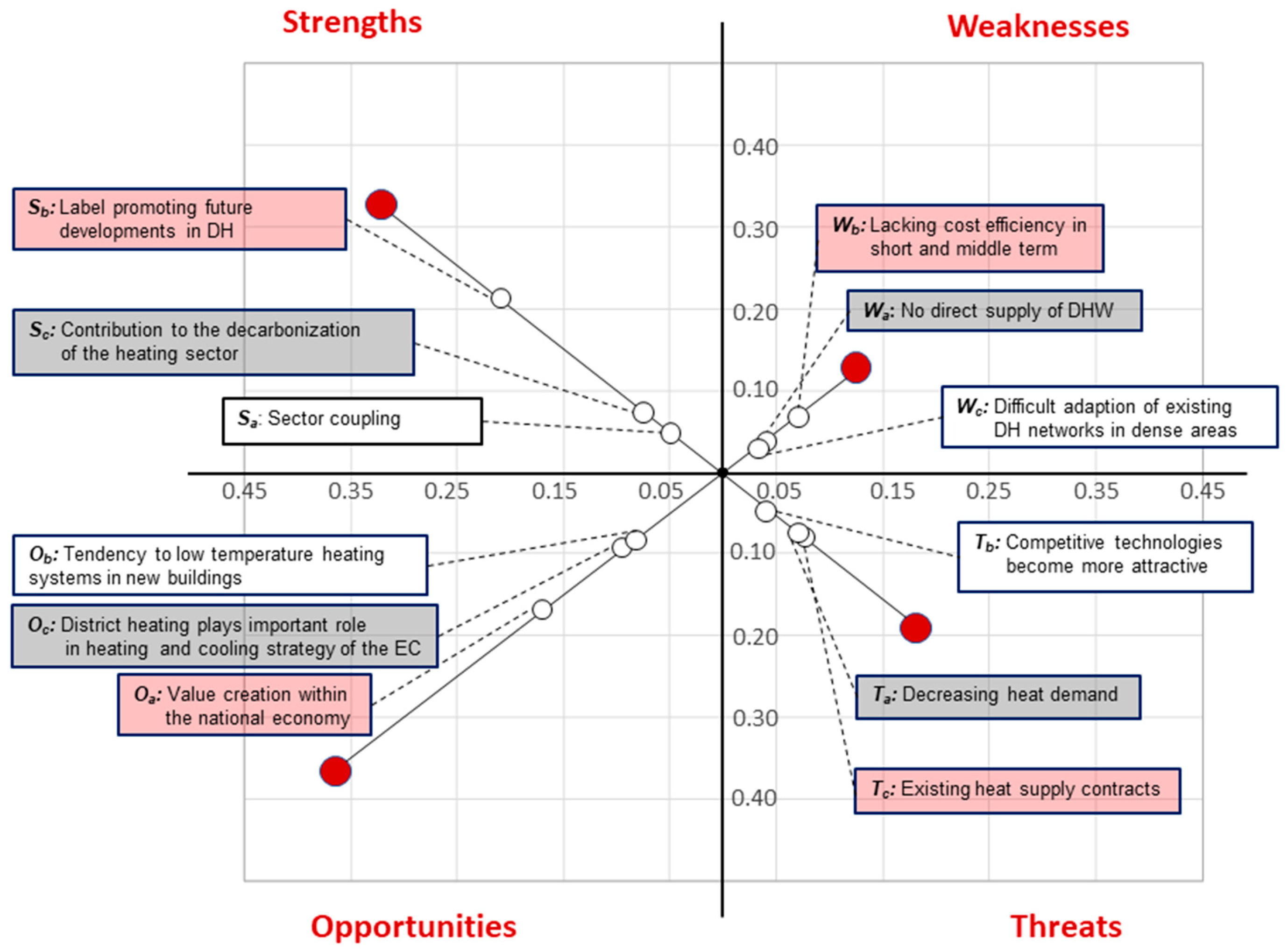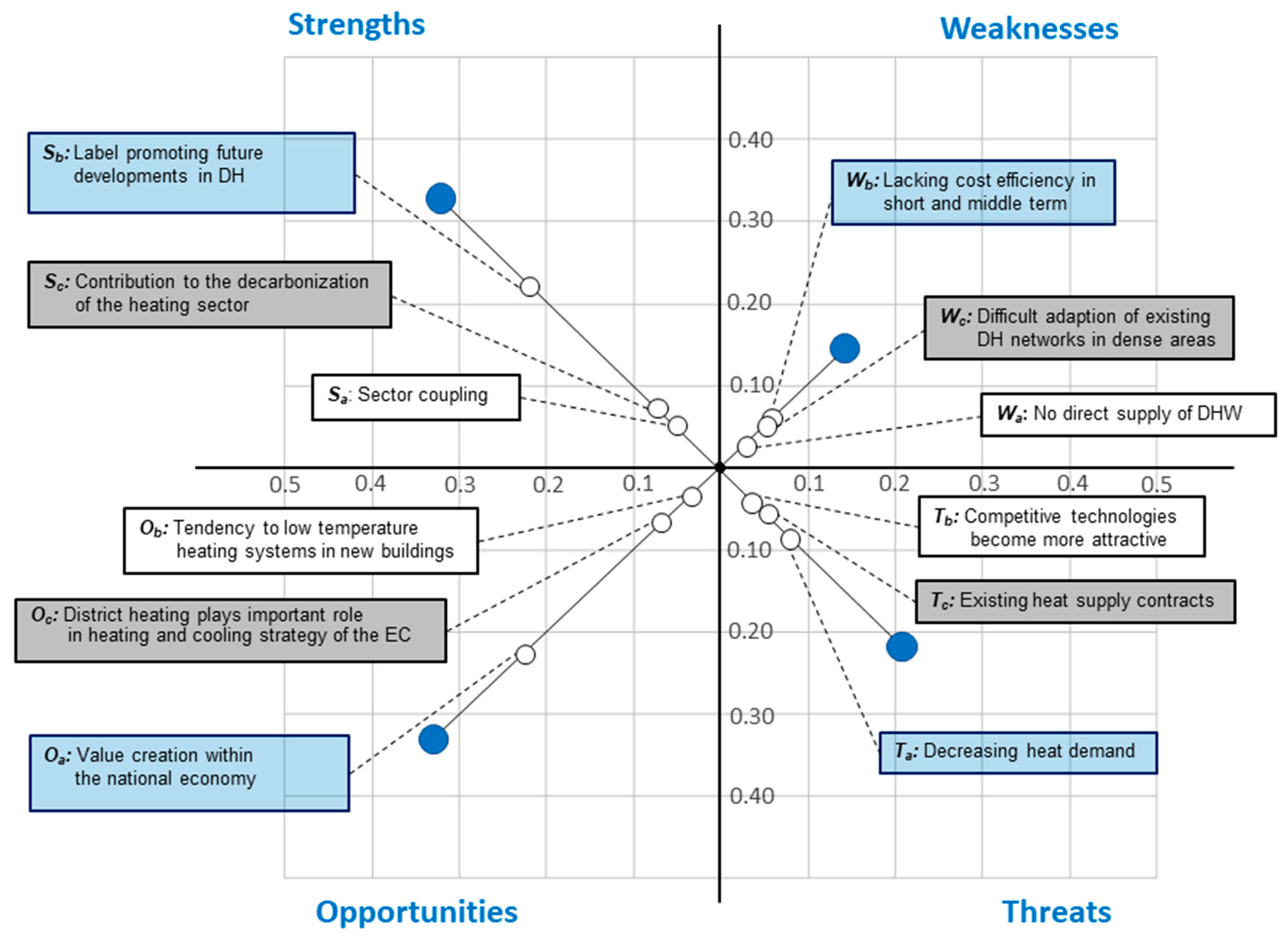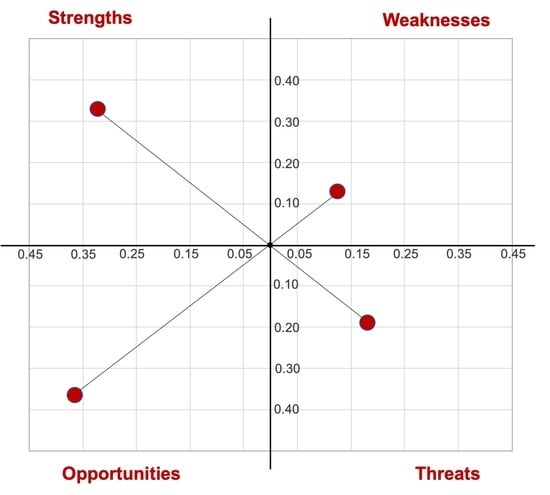District Heating Systems: An Analysis of Strengths, Weaknesses, Opportunities, and Threats of the 4GDH
Abstract
1. Introduction
Main Contribution
2. Method
2.1. Presentation of the Results
2.2. Threats to Validity and Limitations of the Study
3. Results and Discussion
3.1. SWOT-AHP Analysis
3.2. Additional Quantitative Questions
4. Conclusions
- Positive factors, i.e., strengths and opportunities, are considered to be more important than their negative counterparts, weaknesses and threats.
- Both academic and practical experts assigned the same two elements the highest global importance, with a difference only in the order they assigned to them. While academic experts consider the factor “label promoting future developments in district heating” to be the most important, the practitioner experts considered “value creation within the national economy” as most important. The authors consider the introduction of a 5th generation to be inappropriate at the present time.
- The most important research needs identified by the experts are in the field of regulatory frameworks.
Author Contributions
Funding
Acknowledgments
Conflicts of Interest
Appendix A

Appendix B
- [Sa]: It supports sector coupling by the integration of the electricity, heating, cooling, and transport sectors
- [Sb]: It serves as a label that bundles and stimulates considerations about the future development of district heating
- [Sc]: It contributes to the decarbonization of the heating sector by using high shares of renewable energy sources and waste heat from processes in industry and commercial buildings
- [Wa]: Direct supply of domestic hot water without additional heating or other water disinfection methods is not possible (due to regulations concerning Legionella bacteria)
- [Wb]: Lacks cost efficiency in the short and middle term
- [Wc]: Difficult adaption of existing district heating networks especially in densely settled areas
- [Oa]: Value creation within the national economy due to the use of local resources
- [Ob]: Tendency to low-temperature heating systems in new buildings
- [Oc]: District heating plays an important role in the heating and cooling strategy of the European Commission
- [Ta]: Decreasing heating demand (through thermal insulation, passive houses, active houses…)
- [Tb]: Competitive technologies becoming more attractive (e.g., heat pumps)
- [Tc]: Existing heat supply contracts which guarantee the consumer a specific supply temperature
References
- IPCC. Global Warming of 1.5 °C An. IPCC Special Report on the Impacts of Global Warming of 1.5 °C above Pre-Industrial Levels and Related Global Greenhouse Gas Emission Pathways, in the Context of Strengthening the Global Response to the Threat of Climate Change; IPCC: Geneva, Switzerland, 2018. [Google Scholar]
- European Commission. Energy Union Package—A Framework Strategy for a Resilient Energy Union with a Forward-Looking Climate Change Policy; COM(2015) 80 Final; European Commission: Brussels, Belgium, 2015; pp. 1–21. [Google Scholar]
- Fleiter, T.; Elsland, R.; Rehfeldt, M.; Steinbach, J.; Reiter, U.; Catenazzi, G.; Jakob, M.; Rutten, C.; Harmsen, R.; Dittmann, F.; et al. EU Profile of heating and cooling demand in 2015. Heat Roadmap Eur. 2017, 3. [Google Scholar]
- Lund, H.; Andersen, A.N.; Østergaard, P.A.; Mathiesen, B.V.; Connolly, D. From electricity smart grids to smart energy systems—A market operation based approach and understanding. Energy 2012, 42, 96–102. [Google Scholar] [CrossRef]
- Schmidt, D. Low Temperature District Heating for Future Energy Systems. Energy Procedia 2018, 149, 595–604. [Google Scholar] [CrossRef]
- Lund, H.; Werner, S.; Wiltshire, R.; Svendsen, S.; Thorsen, J.E.; Hvelplund, F.; Mathiesen, B.V. 4th Generation District Heating (4GDH). Integrating smart thermal grids into future sustainable energy systems. Energy 2014, 68, 1–11. [Google Scholar] [CrossRef]
- Lake, A.; Rezaie, B.; Beyerlein, S. Review of district heating and cooling systems for a sustainable future. Renew. Sustain. Energy Rev. 2017, 67, 417–425. [Google Scholar] [CrossRef]
- Nord, N.; Nielsen, E.K.L.; Kauko, H.; Tereshchenko, T. Challenges and potentials for low-temperature district heating implementation in Norway. Energy 2018, 151, 889–902. [Google Scholar] [CrossRef]
- Tunzi, M.; Østergaard, D.S.; Svendsen, S.; Boukhanouf, R.; Cooper, E. Method to investigate and plan the application of low temperature district heating to existing hydraulic radiator systems in existing buildings. Energy 2016, 113, 413–421. [Google Scholar] [CrossRef]
- Tian, Z.; Zhang, S.; Deng, J.; Fan, J.; Huang, J.; Kong, W.; Perers, B.; Furbo, S. Large-scale solar district heating plants in Danish smart thermal grid: Developments and recent trends. Energy Convers. Manag. 2019, 189, 67–80. [Google Scholar] [CrossRef]
- Popovski, E.; Aydemir, A.; Fleiter, T.; Bellstädt, D.; Büchele, R.; Steinbach, J. The role and costs of large-scale heat pumps in decarbonising existing district heating networks—A case study for the city of Herten in Germany. Energy 2019, 180, 918–933. [Google Scholar] [CrossRef]
- Dahash, A.; Ochs, F.; Janetti, M.B.; Streicher, W. Advances in seasonal thermal energy storage for solar district heating applications: A critical review on large-scale hot-water tank and pit thermal energy storage systems. Appl. Energy 2019, 239, 296–315. [Google Scholar] [CrossRef]
- Hast, A.; Rinne, S.; Syri, S.; Kiviluoma, J. The role of heat storages in facilitating the adaptation of district heating systems to large amount of variable renewable electricity. Energy 2017, 137, 775–788. [Google Scholar] [CrossRef]
- Watson, J.; Gross, R.; Ketsopoulou, I.; Winskel, M. The impact of uncertainties on the UK’s medium-term climate change targets. Energy Policy 2015, 87, 685–695. [Google Scholar] [CrossRef]
- Zaunbrecher, B.S.; Arning, K.; Falke, T.; Ziefle, M. No pipes in my backyard?: Preferences for local district heating network design in Germany. Energy Res. Soc. Sci. 2016, 14, 90–101. [Google Scholar] [CrossRef]
- Paiho, S.; Saastamoinen, H. How to develop district heating in Finland? Energy Policy 2018, 122, 668–676. [Google Scholar] [CrossRef]
- Lygnerud, K. Challenges for business change in district heating. Energy. Sustain. Soc. 2018, 8, 20. [Google Scholar] [CrossRef]
- Li, H.; Sun, Q.; Zhang, Q.; Wallin, F. A review of the pricing mechanisms for district heating systems. Renew. Sustain. Energy Rev. 2015, 42, 56–65. [Google Scholar] [CrossRef]
- Cirule, D.; Pakere, I.; Blumberga, D. Legislative Framework for Sustainable Development of the 4th Generation District Heating System. Energy Procedia 2016, 95, 344–350. [Google Scholar] [CrossRef]
- Elsevier (Ed.) Scopus. 2019. Available online: https://www.scopus.com/ (accessed on 1 April 2019).
- Mayring, P. Qualitative Content Analysis. Companion Qual. Res. 2004, 1, 159–176. [Google Scholar]
- Saaty, T.L. Decision Making for Leaders: The Analytic Hierarchy Process for Decisions in a Complex World, 3rd ed.; RWS Publications: Pittsburgh, PA, USA, 1999. [Google Scholar]
- Posch, A.; Brudermann, T.; Braschel, N.; Gabriel, M. Strategic energy management in energy-intensive enterprises: A quantitative analysis of relevant factors in the Austrian paper and pulp industry. J. Clean. Prod. 2015, 90, 291–299. [Google Scholar] [CrossRef]
- Brudermann, T.; Mitterhuber, C.; Posch, A. Agricultural biogas plants—A systematic analysis of strengths, weaknesses, opportunities and threats. Energy Policy 2015. [Google Scholar] [CrossRef]
- Reinsberger, K.; Brudermann, T.; Hatzl, S.; Fleiß, E.; Posch, A. Photovoltaic diffusion from the bottom-up: Analytical investigation of critical factors. Appl. Energy 2015. [Google Scholar] [CrossRef]
- Schweiger, G.; Gomes, C.; Engel, G.; Hafner, I.; Schoeggl, J.; Posch, A.; Nouidui, T. An empirical survey on co-simulation: Promising standards, challenges and research needs. Simul. Model. Pract. Theory 2019, 95, 148–163. [Google Scholar] [CrossRef]
- Schweiger, G.; Nilsson, H.; Schoeggl, J.; Birk, W.; Posch, A. Modeling and simulation of large-scale systems: A systematic comparison of modeling paradigms. Appl. Math. Comput. 2020, 365, 124713. [Google Scholar] [CrossRef]
- Saaty, T.L. Axiomatic Foundation of the Analytic Hierarchy Process. Manag. Sci. 1986, 32, 841–855. [Google Scholar] [CrossRef]
- Hallowell, M.R.; Gambatese, J.A. Qualitative Research: Application of the Delphi Method to CEM Research. J. Constr. Eng. Manag. 2010, 136, 99–107. [Google Scholar] [CrossRef]
- Sachs, L. Angewandte Statistik; Springer: Berlin/Heidelberg, Germany, 1997. [Google Scholar]
- Hedderich, J.; Sachs, L. Angewandte Statistik Methodensammlung mit R, 14th ed.; Springer: Berlin/Heidelberg, Germany, 2012. [Google Scholar]
- Lund, H.; Østergaard, P.A.; Chang, M.; Werner, S.; Svendsen, S.; Sorknæs, P.; Thorsen, J.E.; Hvelplund, F.; Mortensen, B.O.G.; Mathiesen, B.V.; et al. The status of 4th generation district heating: Research and results. Energy 2018, 164, 147–159. [Google Scholar] [CrossRef]
- Schweiger, G.; Rantzer, J.; Ericsson, K.; Lauenburg, P. The potential of power-to-heat in Swedish district heating systems. Energy 2017, 137, 661–669. [Google Scholar] [CrossRef]
- Yang, X.; Li, H.; Svendsen, S. Decentralized substations for low-temperature district heating with no Legionella risk, and low return temperatures. Energy 2016, 110, 65–74. [Google Scholar] [CrossRef]
- Zhang, X.; Strbac, G.; Teng, F.; Djapic, P. Economic assessment of alternative heat decarbonisation strategies through coordinated operation with electricity system—UK case study. Appl. Energy 2018, 222, 79–91. [Google Scholar] [CrossRef]
- Gerres, T.; Ávila, J.P.C.; Llamas, P.L.; Román, T.G.S. A review of cross-sector decarbonisation potentials in the European energy intensive industry. J. Clean. Prod. 2019, 210, 585–601. [Google Scholar] [CrossRef]
- Frederiksen, S.; Werner, S. District Heating and Cooling; Studentlitteratur: Lund, Sweden, 2013. [Google Scholar]
- EC. An EU Strategy on Heating and Cooling (COM(2016) 51 Final); EC: Brussels, Belgium, 2016. [Google Scholar]
- Ziemele, J.; Cilinskis, E.; Blumberga, D. Pathway and restriction in district heating systems development towards 4th generation district heating. Energy 2018, 152, 108–118. [Google Scholar] [CrossRef]
- Park, C.; Jeong, Y.; Yoo, S.J. A study of consumer benefit from district heating service in Korea. Energy Policy 2019, 129, 958–966. [Google Scholar] [CrossRef]
- Valodka, I.; Valodkienė, G. The Impact of Renewable Energy on the Economy of Lithuania. Procedia-Soc. Behav. Sci. 2015, 213, 123–128. [Google Scholar] [CrossRef]
- Martin, M.; Røyne, F.; Ekvall, T.; Moberg, Å. Life Cycle Sustainability Evaluations of Bio-Based Value Chains: Reviewing the Indicators from A Swedish Perspective. Sustainability 2018, 10, 547. [Google Scholar] [CrossRef]
- Best, I.; Orozaliev, J.; Vajen, K. Economic comparison of low-temperature and ultra-low-temperature district heating for new building developments with low heat demand densities in Germany. Int. J. Sustain. Energy Plan. Manag. 2018, 16, 45–60. [Google Scholar]
- Averfalk, H.; Werner, S. Novel low temperature heat distribution technology. Energy 2018, 145, 526–539. [Google Scholar] [CrossRef]
- Rønneseth, Ø.; Sandberg, N.H.; Sartori, I. Is It Possible to Supply Norwegian Apartment Blocks with 4th Generation District Heating? Energies 2019, 12, 941. [Google Scholar] [CrossRef]
- Averfalk, H.; Werner, S. Essential improvements in future district heating systems. Energy Procedia 2017, 116, 217–225. [Google Scholar] [CrossRef]
- Vivian, J.; Emmi, G.; Zarrella, A.; Jobard, X.; Pietruschka, D.; de Carli, M. Evaluating the cost of heat for end users in ultra low temperature district heating networks with booster heat pumps. Energy 2018, 153, 788–800. [Google Scholar] [CrossRef]
- Grundahl, L.; Nielsen, S.; Möller, B. Comparison of district heating expansion potential based on consumer-economy or socio-economy. Energy 2016, 115, 1771–1778. [Google Scholar] [CrossRef]
- European Commission. Energy 2020—A Strategy for Competitive, Sustainable and Secure Energy; European Commission: Brussels, Belgium, 2011. [Google Scholar]
- Buffa, S.; Cozzini, M.; D’Antoni, M.; Baratieri, M.; Fedrizzi, R. 5th generation district heating and cooling systems: A review of existing cases in Europe. Renew. Sustain. Energy Rev. 2019, 104, 504–522. [Google Scholar] [CrossRef]
- Boesten, S.; Ivens, W.; Dekker, S.C.; Eijdems, H. 5th generation district heating and cooling systems as a solution for renewable urban thermal energy supply. Adv. Geosci. 2019, 49, 129–136. [Google Scholar] [CrossRef]
- Skytte, K.; Olsen, O.J. Regulatory barriers for flexible coupling of the Nordic power and district heating markets. In Proceedings of the 2016 13th International Conference on the European Energy Market (EEM), Porto, Portugal, 6–9 June 2016; pp. 1–5. [Google Scholar]
- Skytte, K.; Olsen, O.J.; Soysal, E.R.; Sneum, D.M. Barriers for district heating as a source of flexibility for the electricity system. J. Energy Mark. Forthcom. 2017, 10, 1–19. [Google Scholar] [CrossRef]
- Werner, S. District heating and cooling in Sweden. Energy 2017, 126, 419–429. [Google Scholar] [CrossRef]
- Best, I.; Orozaliev, J.; Vajen, K. Impact of Different Design Guidelines on the Total Distribution Costs of 4th Generation District Heating Networks. Energy Procedia 2018, 149, 151–160. [Google Scholar] [CrossRef]
- Averfalk, H.; Ottermo, F.; Werner, S. Pipe Sizing for Novel Heat Distribution Technology. Energies 2019, 12, 1276. [Google Scholar] [CrossRef]
- Nussbaumer, T.; Thalmann, S. Influence of system design on heat distribution costs in district heating. Energy 2016, 101, 496–505. [Google Scholar] [CrossRef]



| Approach | Research | Practitioner | ||||
|---|---|---|---|---|---|---|
| Academic Experts | Public Authorities | Building Project Organizers | Network Operators | Other | Total | |
| SWOT Phase 1 qualitative | 3 | 2 | 2 | 1 | - | 8 |
| SWOT Phase 2 semi-quantitative | 24 | 4 | 3 | 8 | 2 | 41 |
| Qualitative Questions (Phase 2) | 24 | 3 | 3 | 8 | 2 | 40 |
| Positive | Negative | |
| Internal | Strengths | Weaknesses |
| Sa: Sector coupling [32,33] | Wa: No direct supply of DHW [6,34] | |
| Sb: Label promoting future developments in district heating | Wb: Lacks cost efficiency in the short and middle term [7,35] | |
| Sc: Contribution to the decarbonization of the heating sector [36] | Wc: Difficult adaption of existing district heating networks in dense areas [37] | |
| External | Opportunities | Threats |
| Oa: Value creation within the national economy [38,39,40,41,42] | Ta: Decreasing heat demand [43,44] | |
| Ob: Tendency to low-temperature heating systems in new buildings [6,45] | Tb: Competitive technologies becoming more attractive [39,46,47,48] | |
| Oc: District heating plays an important role in the heating and cooling strategy of the European Commission [49] | Tc: Existing heat supply contracts |
| SWOT Factors | Local Priority | Global Priority | |
|---|---|---|---|
| Strengths Priority: 0.33 CR: 1.5% | Sa: Sector coupling Sb: Label promoting future developments in district heating Sc: Contribution to the decarbonization of the heating sector | 0.16 0.62 a 0.22 | 0.053 0.201 b 0.072 |
| Weaknesses Priority: 0.13 CR: 0.6% | Wa: No direct supply of DHW Wb: Lacks cost efficiency in the short and middle term Wc: Difficult adaption of existing district heating networks in dense areas | 0.27 0.49 a 0.24 | 0.034 0.062 0.031 |
| Opportunities Priority: 0.37 CR: 0.1% | Oa: Value creation within the national economy Ob: Tendency to low-temperature heating systems in new buildings Oc: District heating plays an important role in the heating and cooling strategy of the European Commission | 0.45a 0.24 0.32 | 0.165 0.087 0.116 |
| Threats Priority: 0.18 CR: 4% | Ta: Decreasing heat demand Tb: Competitive technologies becoming more attractive Tc: Existing heat supply contracts | 0.36 0.27 0.37 a | 0.070 0.037 0.073 |
| SWOT Factors | Local Priority | Global Priority | |
|---|---|---|---|
| Strengths Priority: 0.32 CR: 1.52% | Sa: Sector coupling Sb: Label promoting future developments in district heating Sc: Contribution to the decarbonization of the heating sector | 0.15 0.65 a 0.20 | 0.047 0.211 0.064 |
| Weaknesses Priority: 0.14 CR: 0.2% | Wa: No direct supply of DHW Wb: Lacks cost efficiency in the short and middle term Wc: Difficult adaption of existing district heating networks in dense areas | 0.30 0.36 a 0.34 | 0.042 0.051 0.048 |
| Opportunities Priority: 0.33 CR: 3.2% | Oa: Value creation within the national economy Ob: Tendency to low-temperature heating systems in new buildings Oc: District heating plays an important role in the heating and cooling strategy of the European Commission | 0.70a 0.11 0.19 | 0.231b 0.037 0.063 |
| Threats Priority: 0.20 CR: 4.6% | Ta: Decreasing heat demand Tb: Competitive technologies becoming more attractive Tc: Existing heat supply contracts | 0.44a 0.26 0.30 | 0.079 0.066 0.059 |
| SWOT Factors | Global Priority | Global Rank | |
|---|---|---|---|
| Strengths Priority: 0.32 CR: 1.5% | Sa: Sector coupling Sb: Label promoting future developments in district heating Sc: Contribution to the decarbonization of the heating sector | 0.05 0.205 0.068 | 9 1 5 |
| Weaknesses Priority: 0.13 CR: 0.4% | Wa: No direct supply of DHW Wb: Lack of cost efficiency in the short and middle term Wc: Difficult adaption of existing district heating networks in dense areas | 0.038 0.058 0.037 | 11 8 12 |
| Opportunities Priority: 0.36 CR: 0.8% | Oa: Value creation within the national economy Ob: Tendency to low-temperature heating systems in new buildings Oc: District heating plays an important role in the heating and cooling strategy of the European Commission | 0.190 0.068 0.098 | 2 6 3 |
| Threats Priority: 0.19 CR: 4.3% | Ta: Decreasing heat demand Tb: Competitive technologies becoming more attractive Tc: Existing heat supply contracts | 0.098 0.047 0.067 | 4 10 7 |
| Mean | Median | Interp. Median | |
|---|---|---|---|
| Regulatory frameworks for 4GDH are already developed (e.g., bans on oil and gas boilers, CO2 taxes...). | 2.88 | 2 | 2.23 |
| User confidence in new technology has been sufficiently investigated. | 2.83 | 2.5 | 2.50 |
| Facilitating active consumer participation has been sufficiently investigated (e.g., via mobile applications, gamification). | 3.29 | 3 | 3.13 |
| User behavior has been sufficiently investigated (e.g., increasing comfort standard). | 3.46 | 3 | 3.17 |
| Sophisticated control tools have already been developed and available (cross-domain, fully dynamic analysis; predictive control algorithms). | 3.50 | 3.5 | 3.50 |
| The impact of temperature errors in district heating systems has been sufficiently investigated (e.g., substations generating too high return temperatures). | 3.46 | 3.5 | 3.50 |
| Construction standards have been consequently considered to avoid peak demands (e.g., by integrating storage mass into buildings). | 3.50 | 4 | 3.67 |
| Smart metering (with intelligent control systems) has been sufficiently investigated. | 3.83 | 4 | 3.90 |
| Sophisticated planning tools are already developed (cross-domain, fully dynamic analysis). | 3.71 | 4 | 4.00 |
| Renovation costs for buildings have been sufficiently investigated. | 4 | 4 | 4.00 |
| Alternative options to avoid Legionella growth in domestic hot water have been sufficiently investigated (e.g., infrared cleaning, apartment substations instead of central hot water supply). | 4 | 4 | 4.00 |
| Load forecasting methods have been sufficiently investigated (e.g., based on artificial intelligence techniques). | 4.21 | 4 | 4.17 |
| The impact of increasing pump energy demand caused by a lower temperature difference between supply and return temperature has been sufficiently investigated. | 4.33 | 4 | 4.36 |
| Mean | Median | Interp. Median | |
|---|---|---|---|
| Regulatory frameworks for 4GDH are already developed (e.g., bans of oil and gas boilers, CO2 taxes...). | 3.31 | 2.5 | 2.50 |
| Construction standards have been given thorough consideration as a means of avoiding peak demands (e.g., by integrating storage mass into buildings). | 3.40 | 3 | 3.00 |
| User confidence in new technology has been sufficiently investigated. | 3.60 | 4 | 3.00 |
| Sophisticated planning tools have already been developed (cross-domain, fully dynamic analysis). | 3.73 | 4 | 3.33 |
| Facilitating active consumer participation has been sufficiently investigated (e.g., via mobile applications, gamification). | 3.80 | 4 | 3.67 |
| The impact of temperature errors in district heating systems has been sufficiently investigated (e.g., substations generating too high return temperatures). | 3.87 | 4 | 3.80 |
| Smart metering (with intelligent control systems) has been sufficiently investigated. | 3.87 | 5 | 4.40 |
| Load forecasting methods have been sufficiently investigated (e.g., based on artificial intelligence techniques). | 4 | 4 | 4.00 |
| User behavior has been sufficiently investigated (e.g., increasing comfort standard). | 4 | 4 | 4.13 |
| Sophisticated control tools have already been developed (cross-domain, fully dynamic analysis; predictive control algorithms). | 4.07 | 4 | 4.13 |
| Alternative options to avoid Legionella growth in domestic hot water have been sufficiently investigated (e.g., infrared cleaning, apartment substations instead of central hot water supply). | 4.27 | 4 | 4.20 |
| Renovation costs for buildings have been sufficiently investigated. | 4 | 5 | 4.33 |
| The impact of increasing pump energy demand caused by a lower temperature difference between supply and return temperature has been sufficiently investigated. | 4.47 | 5 | 4.67 |
© 2019 by the authors. Licensee MDPI, Basel, Switzerland. This article is an open access article distributed under the terms and conditions of the Creative Commons Attribution (CC BY) license (http://creativecommons.org/licenses/by/4.0/).
Share and Cite
Schweiger, G.; Kuttin, F.; Posch, A. District Heating Systems: An Analysis of Strengths, Weaknesses, Opportunities, and Threats of the 4GDH. Energies 2019, 12, 4748. https://doi.org/10.3390/en12244748
Schweiger G, Kuttin F, Posch A. District Heating Systems: An Analysis of Strengths, Weaknesses, Opportunities, and Threats of the 4GDH. Energies. 2019; 12(24):4748. https://doi.org/10.3390/en12244748
Chicago/Turabian StyleSchweiger, Gerald, Fabian Kuttin, and Alfred Posch. 2019. "District Heating Systems: An Analysis of Strengths, Weaknesses, Opportunities, and Threats of the 4GDH" Energies 12, no. 24: 4748. https://doi.org/10.3390/en12244748
APA StyleSchweiger, G., Kuttin, F., & Posch, A. (2019). District Heating Systems: An Analysis of Strengths, Weaknesses, Opportunities, and Threats of the 4GDH. Energies, 12(24), 4748. https://doi.org/10.3390/en12244748







